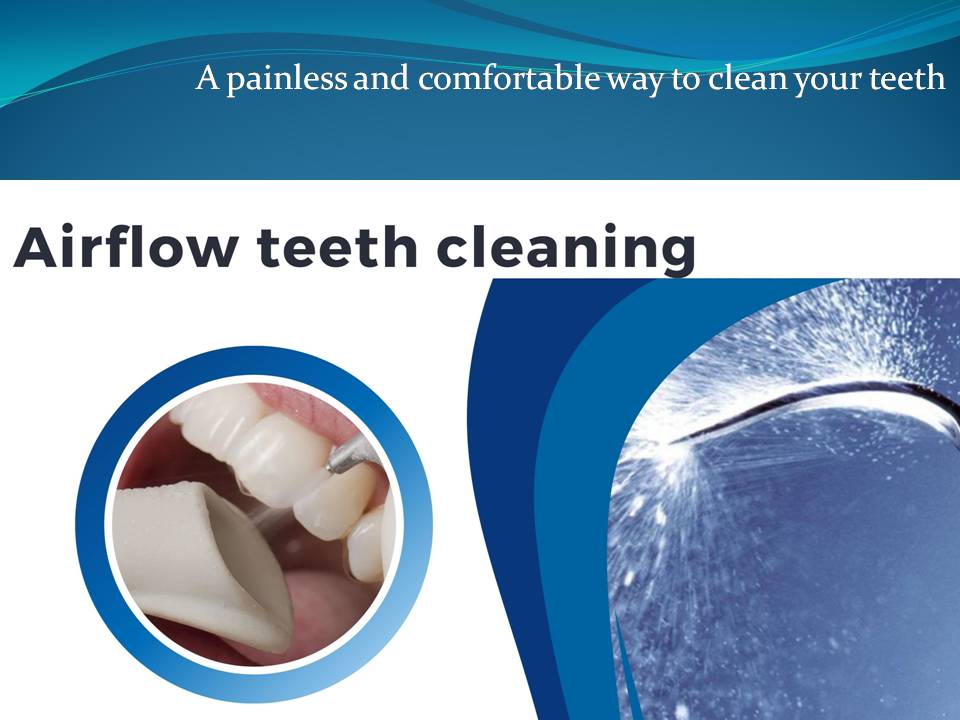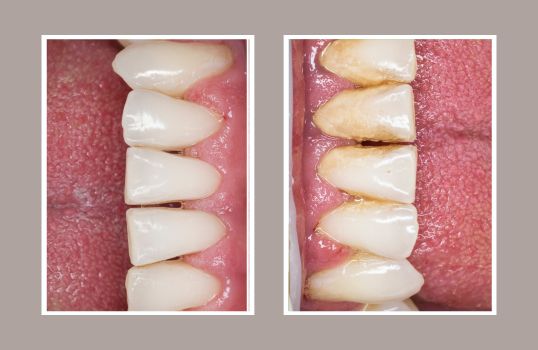
Many people face dental problems such as plaque, tartar, or stains on their teeth. If these dental problems remain untreated, they can disrupt oral hygiene and lead to various dental and gum diseases.
Those who prioritize oral hygiene regularly get their teeth cleaned to address these problems. Maybe you are one of those who care about oral hygiene and want to get rid of plaque, tartar, or stains on your teeth in a single session, and you want the effect of the procedure to last longer.
Advances in dental technology have introduced new methods to cure all kinds of dental and gum problems, as well as a beneficial procedure for cleaning teeth. This procedure is called “airflow teeth cleaning." This procedure makes dental care more efficient, comfortable, and accessible to a wider population.
What distinguishes the airflow teeth cleaning procedure from the traditional one, and how does it operate? Are these the first questions that come to your mind? Of course, you may have additional questions about the Airflow teeth cleaning procedure and would like to know where to find the answers. So, let's examine the airflow teeth cleaning procedure, which is a new technology and a new approach, and help you decide whether to prefer traditional teeth cleaning or the airflow teeth cleaning method.
What instruments are used in the traditional teeth cleaning procedure?
Traditional teeth cleaning uses mechanical and electrical devices, scaling instruments, and polishing instruments to remove plaque and tartar from teeth and remove tooth stains.
Are there limitations to the traditional teeth cleaning procedure?
Although traditional teeth cleaning methods are effective, some patients with sensitive teeth and gums may sometimes feel discomfort and sensitivity during mechanical scaling.
In traditional dental cleaning procedures, mechanical tools sometimes carry the risk of eroding tooth enamel. Sometimes, deep stains and plaque in hard-to-reach areas cannot be fully cleaned.
Traditional dental cleaning methods do not effectively address the biofilm that forms on teeth. If the biofilm is not completely eliminated, it can lead to the risk of tooth decay and gum disease.
To overcome these limitations of the traditional teeth cleaning procedure, the airflow teeth cleaning procedure was developed.
What is airflow teeth cleaning?
Airflow teeth cleaning is a procedure that uses a controlled flow of air, water, and specially formulated powders to remove plaque and tartar from hard-to-reach areas (periodontal pockets below the gum line, etc.) and remove tooth stains.

How does the airflow teeth cleaning procedure work?
Airflow teeth cleaning uses a combination of warm water, compressed air, and a special bicarbonate powder. The treatment is performed with an airflow nozzle that combines this combination and sprays it in a pulverized form.
The warm water and powder particles are sprayed with a controlled pressure without direct contact with the surface of the teeth. This gently and effectively removes plaque, tartar, and stains. With the perioflow extension nozzle, polishing is performed with a non-irritating airflow to clean the gums and teeth at the subgingival level or just below the gums.
Which teeth and gum problems are improved with Airflow teeth cleaning?
The following tooth and gum diseases can be treated with the Airflow teeth cleaning method:
Tartar and plaque:
Tartar and plaque can be easily removed with airflow teeth cleaning.
Tooth stains:
Stains on the teeth caused by various external factors such as cigarettes, tea, and coffee can be cleaned with the airflow teeth cleaning method to whiten the teeth and achieve an aesthetic appearance.
Biofilm and halitosis
When left on teeth, biofilm acts as a protective layer for bacteria, allowing them to grow and multiply. With airflow teeth cleaning, the biofilm structure is broken down and removed from tooth surfaces and the gum line. Thus, biofilm and halitosis-causing bacteria can be effectively removed, and bad breath can be prevented.
Gum recession:
With the airflow teeth cleaning procedure, cleaning can be done without damaging the gums, which can speed up the recovery of gum health.
Gingivitis
Airflow teeth cleaning can relieve gingivitis by removing bacterial plaque near the gum line.
How is airflow teeth cleaning applied?
Like every procedure, airflow teeth cleaning also requires a preparation phase. The patient may have consulted the dentist to ensure general dental cleaning and oral hygiene or to treat problems with their teeth and gums. The dentist first conducts a physical examination of the patient's oral cavity. Then, using various radiological imaging methods, the dentist identifies the patient's tooth and gum structure and problems. If the patient has an infection, the dentist may first recommend treatment.
Of course, it is also important whether the patient wants the traditional teeth cleaning method or the new technology of airflow teeth cleaning procedure.
If the patient prefers the airflow teeth cleaning procedure and the dentist assesses that the airflow teeth cleaning procedure will be more beneficial to eliminate the patient's problems and decides that the patient is suitable for this procedure, the procedure is initiated.
Airflow teeth cleaning is painless for most patients and generally does not require anesthesia. However, if the patient has a special condition, the dentist may administer anesthesia. The dentist then operates a device that mixes warm water, a special powder mixture, and air. This mixture comes from the device's chamber to a probe with a nozzle at the end. The dentist adjusts the pressure of the mixture spraying from the nozzle and directs it to the surface of the teeth and problem areas, softening and removing plaque, tartar, and stains on the teeth.
Water cleans the residues while the powder particles gently abrade and polish the tooth surface. With just light air pressure and minimal contact, it cleans and polishes every area of the mouth, including the gum line, tooth surface, and deeper pockets. Thus, it cleans and smooths the patient's teeth in a single session, relaxes the gums, and improves oral hygiene.
What is the difference between airflow teeth cleaning and traditional teeth cleaning?
The difference lies in the dental cleaning devices and instruments used in both procedures, the methods of using them, and the comfort of the procedure. While traditional teeth cleaning methods use mechanical and electrical scaling devices and instruments, airflow teeth cleaning replaces them with a combination of water, air, and specially mixed powder. Airflow teeth cleaning becomes a good option for patients who value more comfort during treatment.
What are the benefits and advantages of the airflow teeth cleaning procedure?
Effectively removes plaque, tartar, and stains:
The pressurized special blend used in Airflow teeth cleaning can reach areas that may be difficult to clean with traditional methods and provides a more thorough cleaning.
Does not damage tooth enamel and tissues:
Airflow teeth cleaning does not damage the tissues and tooth enamel surgically because it does not require the use of sharp instruments used in traditional methods. Especially for patients who are afraid of the tools used in traditional methods, airflow teeth cleaning is a good option.
Requires a shorter treatment time:
Airflow teeth cleaning is generally faster than traditional teeth cleaning and polishing methods. The effectiveness of airflow teeth cleaning in removing stains and plaque can provide a visibly brighter smile in a single session.
This application is attractive for those who want to improve the aesthetics of their teeth without resorting to more surgical methods. In addition, this procedure provides convenience for both patients and dentists
The variety of applications is wide.
This procedure can also be used to clean dental implants, veneers, bridges, braces, and between brackets.
It has enhanced precision and efficiency:
The airflow teeth cleaning procedure can target specific areas of the teeth and perform a thorough cleaning in a very precise process. It provides a longer lasting and efficient permanence compared to dental cleaning with traditional methods.
It is a good option for sensitive teeth and gums.
Airflow teeth cleaning is usually gentle on the enamel and gums, so patients with sensitive teeth and gums have a reduced risk of damage compared to traditional cleaning methods.
Provides improved oral hygiene in the long term:
This procedure contributes to improved oral hygiene by effectively removing plaque, stains, and biofilm. It even removes bacteria from deep periodontal pockets, reducing the risk of tooth decay, gum disease, and other oral health problems, resulting in cleaner and healthier teeth and gums.
Offers improved aesthetics:
In addition to removing dental plaque, the procedure helps to restore the natural colour of the teeth and provides a more aesthetically pleasing appearance.
What are the risks or disadvantages of the airflow teeth cleaning procedure?
Although the Airflow teeth cleaning procedure does not carry significant risks, like any procedure, it may have some disadvantages. Patients with sensitive teeth and gums may experience excessive sensitivity and pain after the procedure. Temporary tooth sensitivity after treatment is a known side effect of professional dental cleaning. This sensitivity does not last long and is temporary.
Inflammation of the patient's gums or the presence of deep gum pockets that reach the tooth root can cause pain. However, the pain usually subsides quickly. You can use the dentist's recommended pain relievers, depending on the situation.
What needs to be considered after an Airflow teeth cleaning treatment?
Generally, no special care is required after airflow treatment. Patients can return to their normal eating and drinking habits immediately, but avoiding staining foods and beverages for 24 hours can help maintain results.
F.A.Q:
Is airflow teeth cleaning painful?
The procedure is usually painful. However, a short-term sensitivity may be experienced after the procedure, but this usually passes within 1-2 days.
Is airflow teeth cleaning safe?
Yes, airflow teeth cleaning is safe.
How long does airflow teeth cleaning take?
An average appointment lasts around 30 minutes.
How long do the effects of airflow teeth cleaning last?
The duration of the effects may vary according to personal oral hygiene, general health status, and lifestyle habits.
How often should I get airflow teeth cleaning?
It is recommended to get airflow teeth cleaning done every 6 months as part of your oral hygiene routine. However, patients with more severe buildup or gum disease may need more frequent cleanings.
Can airflow teeth cleaning remove stains?
Yes. Airflow can remove stains from up to 5mm deep into the periodontal pockets as well as the surface of the tooth.
Is traditional or airflow teeth cleaning more effective?
Both methods are effective in removing plaque, tartar, and surface stains. However, airflow teeth cleaning may be more effective in removing certain types of stains, such as coffee, tea, and cigarettes.
Does airflow teeth cleaning whiten teeth?
Removes surface stains but does not lighten the basic colour of teeth. Removable stains include tea, coffee, wine, and tobacco stains.
Is airflow teeth cleaning for teeth worth it?
Professional cleaning is highly effective in removing biofilm that leads to cavities, tooth and gum disease, and various other health problems. Airflow teeth cleaning treatment is considered the most effective and efficient way of managing biofilm.
Is airflow teeth cleaning expensive?
The price of airflow teeth cleaning application; Although it varies according to the countries, clinics and the experience of the dentist, a fee of 95 € to 175 € can be expected in the UK, 60 € to 120 € in Germany, and 15 € to 30 € in Turkey.
Are patients satisfied with airflow teeth cleaning?
Many patients who have undergone Airflow teeth cleaning express a high level of satisfaction with the results. Patients appreciate the gentle yet effective nature of Airflow technology, which results in an overall positive dental experience.
